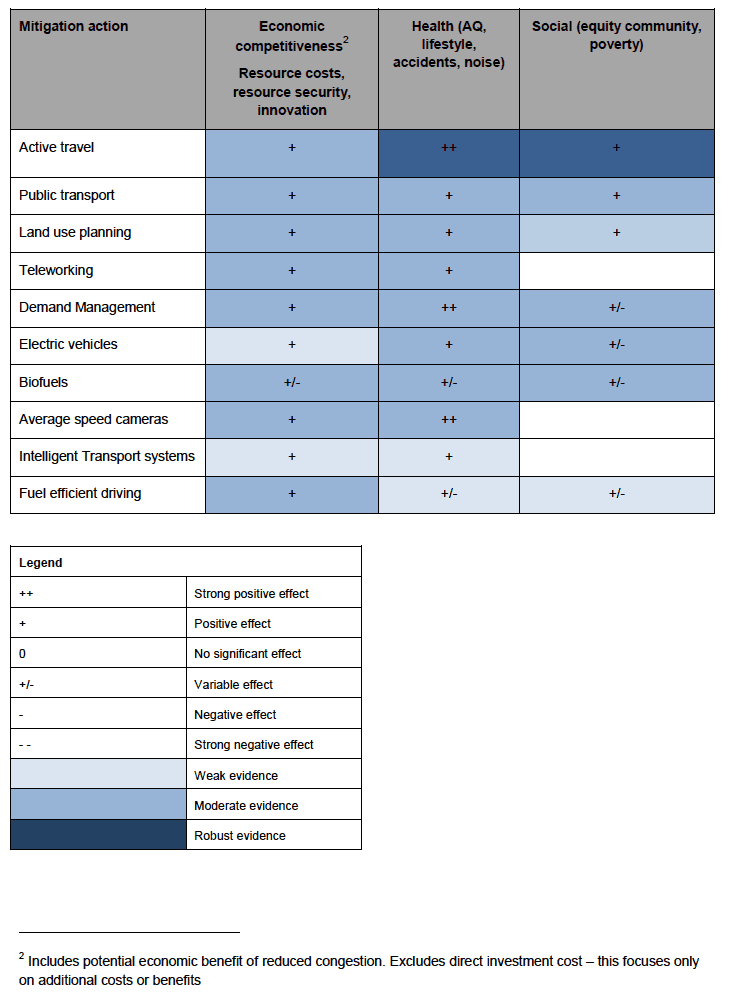Climate change: evidence review of mitigation options in the Transport sector
Evidence review of potential climate change mitigation measures in the Transport sector.
3 Overview of results
3.1 Direction and magnitude of impacts
This Chapter provides an overview of the direction and magnitude of impacts under the shift, reduce, avoid framework, this is complemented by a summary table, and framed within the research questions identified in Section 1.3.
Shift to more sustainable modes (Shift)
- Active travel (increased levels of walking and cycling) dominates the co-benefits literature in qualitative and quantitative (modelling) terms. A key focus is on the health (and associated monetisation) of increased levels of physical activity. However, consideration is also given to the benefits of reductions in car travel including improved air quality and less traffic congestion. The literature and outcomes as they relate to health can be considered mature in many aspects. There are, however, still research gaps. Of particular relevance from an equalities perspective is the social and distributional aspects of these benefits.
- Broader benefits of public transport and car clubs such as facilitating access to employment, and reducing congestion are not typically framed in co-benefits terminology. These benefits can potentially be significant though further evidence is required.
Reduce the need to travel (Avoid)
- Land use planning such as high density mixed use development can reduce the need to travel (by car) and result in associated benefits (in quantifiable and less quantifiable terms) such as reduced travel time and the regeneration of local communities. Land use planning can also help reduce community severance ( e.g. physical barriers which can occur due to the challenges pedestrians face in crossing busy roads) which is particularly pertinent from an equality perspective.
- Teleworking can offer employers and employee benefits. Care is, however, required with regard to work-life boundaries. In addition, heating and lighting costs may increase if energy is used less efficiently in the home than in an office serving many people.
Improve efficiency (Improve)
- There is increasing interest in the air quality and noise benefits of a move towards electrified and other low carbon vehicles e.g. Liquefied petroleum gas ( LPG). While the emphasis is on qualitative aspects there is an emerging literature regarding quantification. Targeted introduction of electric and other vehicles could offer opportunities in terms of reducing the current inequalities around population exposure to higher levels of air pollution.
- With all efficiency improvement measures, there is a possibility of a rebound effect. This is because increased fuel efficiency cuts the costs to the consumer per vehicle kilometre travelled and therefore may result in increased transport activity.
- In terms of network efficiencies, there is current, limited research, but the existing evidence suggests the potential for reductions in road accidents.
In terms of the overall direction and magnitude of impacts, a number of key studies ( e.g. Woodcock et al., 2009; Smith et al., 2015, Brown et al., 2016) that consider positive and negative impacts of climate change mitigation conclude that for transport mitigation actions that the positive impacts can outweigh potential adverse side effects. A qualitative summary is provided below in Table 3-1, which sets out the direction and magnitude of impacts for the different mitigation actions with the rationale covered in the following Chapters.
Table 3‑1 Magnitude and direction of co-impacts for transport mitigation actions

Weak evidence relates to there being limited evidence currently available or that the available evidence is less robust. Robust evidence relates to stronger evidence base relating to the quality of and number of papers. Where there was no current evidence identified through this study the cells were left blank. It should be noted that there could be future evidence e.g. on the equity benefits of average speed cameras - reflecting that road accidents can disproportionately affect disadvantaged socio-economic groups.
There are potential benefits on natural capital (including water, soil, biodiversity, waste) through avoided fuel production for several of the mitigation options including demand reduction and modal shift to active travel. The extent of these benefits will depend on the level of the reduction in fuel use. Biofuels can have potential adverse impacts on natural capital, for example on biodiversity and water quality. The extent of this impact is dependent on fuel stocks used and whether the fuels are first or second generation. For electric vehicles the need for further evidence for example relating to impacts of the extraction of materials to produce the vehicles is identified.
Contact
Email: Debbie Sagar
There is a problem
Thanks for your feedback